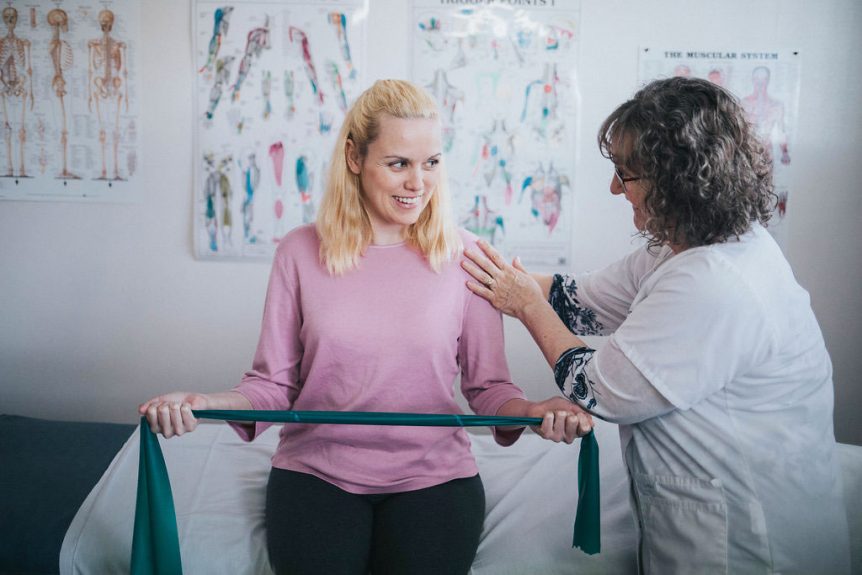At Orthopedic & TMJ Physical Therapy Center we are trained in a variety of advanced hands-on (manual physical therapy) techniques. A combination of these may be used in your healing process.
MANUAL THERAPIES:
Mobilization:
- Therapeutic maneuvers carried out by the therapist on a joint or soft tissue. The joint is passively taken through its available range with gentle stretches or oscillations directed at gradually relieving the restriction. Mobilization techniques may be accompanied by a “snap” signifying the break of an intra-articular adhesion, a “pop” signifying a temporary alteration in the fluid/gas state, or a “sliding sensation” where a joint fixed for a time in a certain position is now able to move to its normal rest position.
Massage/Myofascial Release:
- Massage and fascial techniques are designed to relax specific muscle groups, reduce swelling, release adhesions, and restore movement. Techniques may include general stroking massage, deep friction massage, trigger point work, acupressure and soft tissue mobilization.
Osteopathic Techniques:
- Finding tender points and relieving the associated joint pain by passively putting the joint into its position of greatest comfort. Developed by Dr. Lawrence Jones, D.O.
- Muscle EnergyA method in which precise, voluntary muscle contractions of a patient are exerted against the manual resistance of a therapist to reduce dysfunctional joint mechanics. Developed by Dr. Fred Mitchell, Sr. D.O.
- Craniosacral Therapy The craniosacral system consists of the membranes and cerebrospinal fluid that surround and protect the brain and spinal cord. It extends from the bones of the skull, face, and mouth, which make up the cranium, down to the sacrum, and tailbone area. Restrictions of this system could potentially cause a number of sensory, motor, or neurological disabilities. Craniosacral physical therapy is light touch on your head or body gently detecting then correcting tensions. This encourages the natural healing mechanisms to dissipate the negative effects of tension on your central nervous system.
- Visceral Organ Specific Fascial Releases Hands are gently applied on the abdominal area using precise directional techniques to encourage the normal mobility, tone, and motion of the abdominal viscera and their connective tissues. These gentle manipulations can potentially improve the function of individual organs, the systems that the organs function within, and the structural integrity of the body.
- Lymph Drainage Therapy The LDT process involves the use of subtle manual maneuvers to aide in the recirculation of the lymphatic flow. The therapist works with flat hands, using all the fingers to simulate wave-like movements. By activating fluid, circulation benefits are noted in the areas of decreased edema, increased relaxation, and decreased pain.
Primal Reflex Release Technique
- Primal Reflex Release Technique is a hands-on treatment approach based on the theory that certain primal muscle reflexes become activated when we are in pain or when we experience a traumatic event. This overstimulation of the reflexes maintains pain and keeps painful patterns active. PRRT assesses these reflexes and then treats them by dampening down the reflex response that the body is experiencing. For example, if a muscle is tight, it could be that the tightness is a symptom of an over-sensitive reflex signaling the muscle to remain contracted. The PRRT practitioner aims to remove the reflexive response to the muscle as opposed to merely stretching, massaging, manipulating, or putting a hot pack on it. Our therapist Heather Hannam uses this technique.
Exercise
- Many people exercise but still have dysfunctions. Our goal is to match the type of exercise with the individual and the tissue need with the exercise. Balance is a key. One muscle group may need to be stretched and it’s antagonist strengthened. To do the opposite could maintain a dysfunction. Included in movement is instruction in posture and body mechanics. It is the 23 hours a day that one is out of the Physical Therapist’s office and what self-care habits are developed that make the biggest impact on body function.
MODALITIES:
Biofeedback or sEMG:
- This technique teaches voluntary control over automatically regulated body functions such as muscle tension, breathing, temperature and heart rate. Computerized equipment detects electrical signals of internal bodily functions and translates these signals into a form that patients can detect on a monitor. Surface electrodes, intra-vaginal/rectal electrodes, respiratory cables or thermal/heart rate sensors are placed on the patient, and changes of a small magnitude are observed instantly.
Electrotherapy:
- Electronic stimulation (e-stim) is the administration of electric current for pain control, fluid control, increased circulation or muscle control. The variance of duration, frequency and intensity create different waveforms yielding different types of units: TENS (transcutaneous electrical nerve stimulation), microcurrent, interferential current, galvanic current. Ultrasound: Ultrasound is a supplemental modality that utilizes high-frequency sound waves, which create molecular motion in tissues, generating heat. The ultrasonic wave vibrations penetrate the superficial tissue and reflect on the deep tissue causing movement of stagnant fluid, softening of scar tissue, pain relief, relaxation, and warming of the muscle to prepare for exercise.
Heat/Ice:
- Used in various forms to reduce swelling, inflammation and spasticity.

